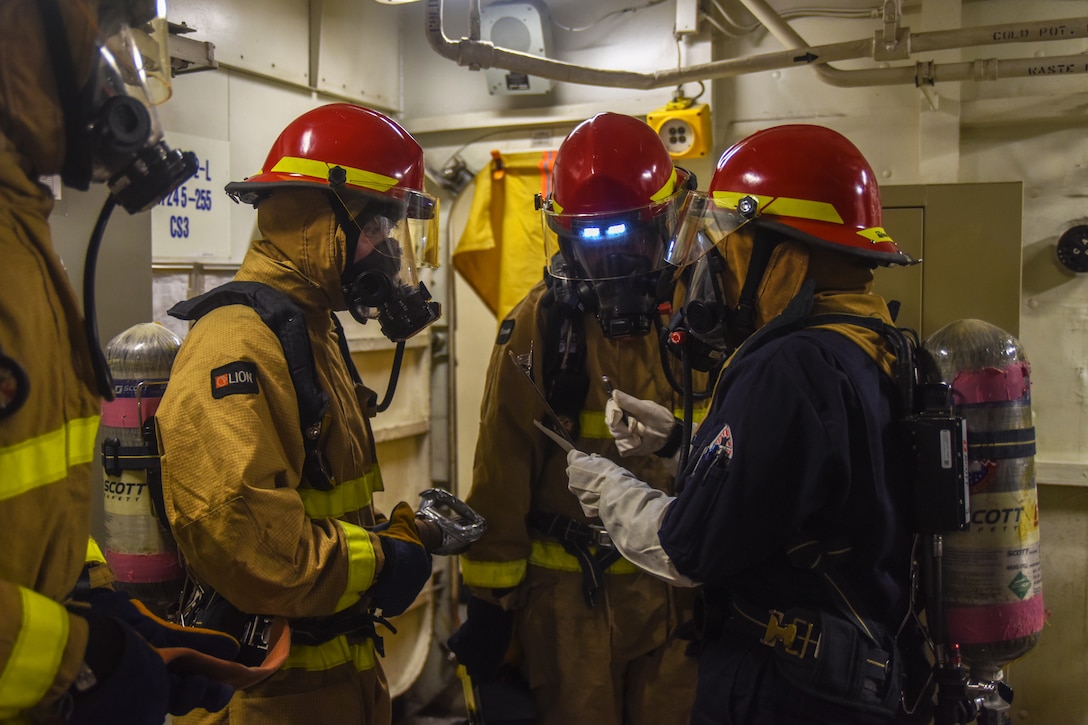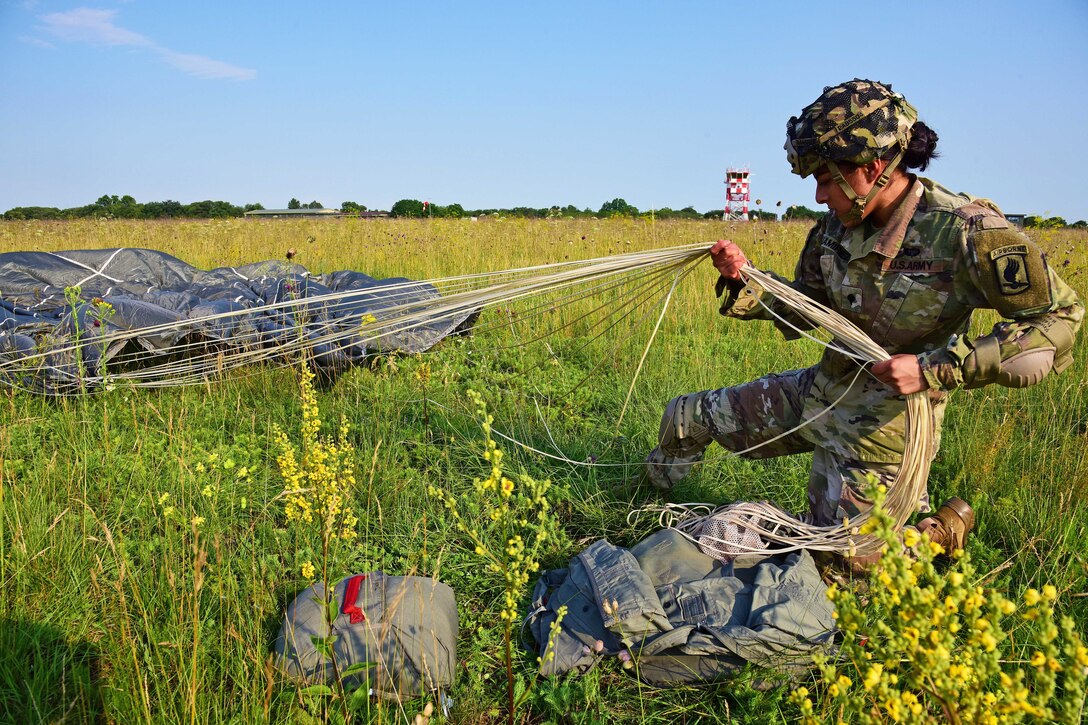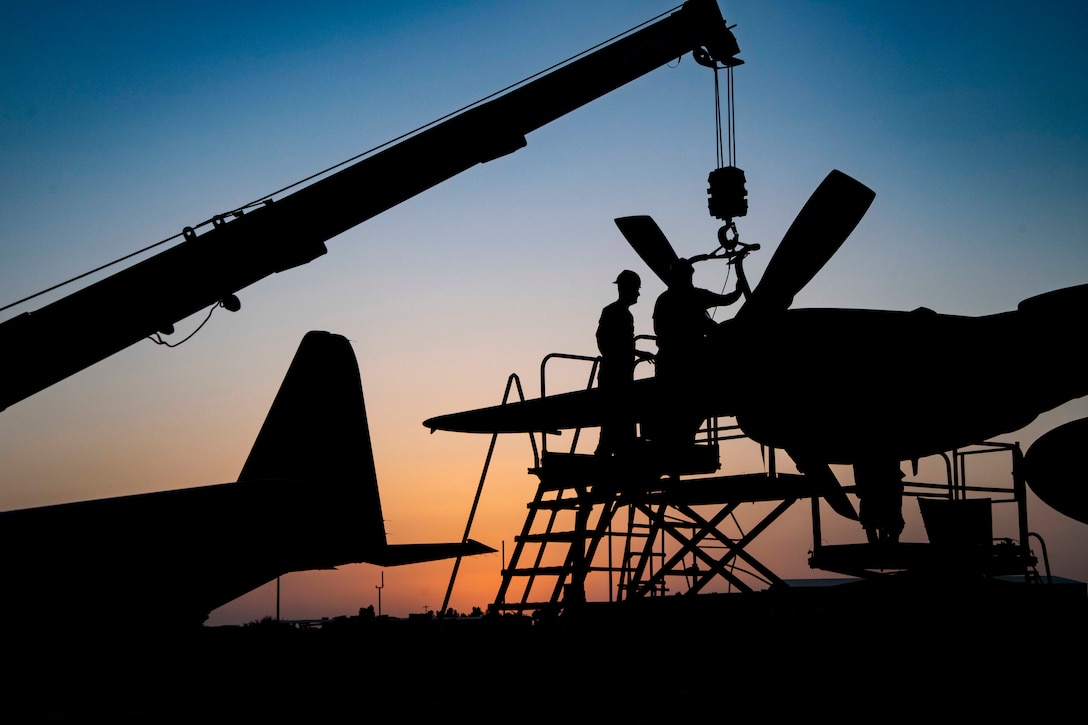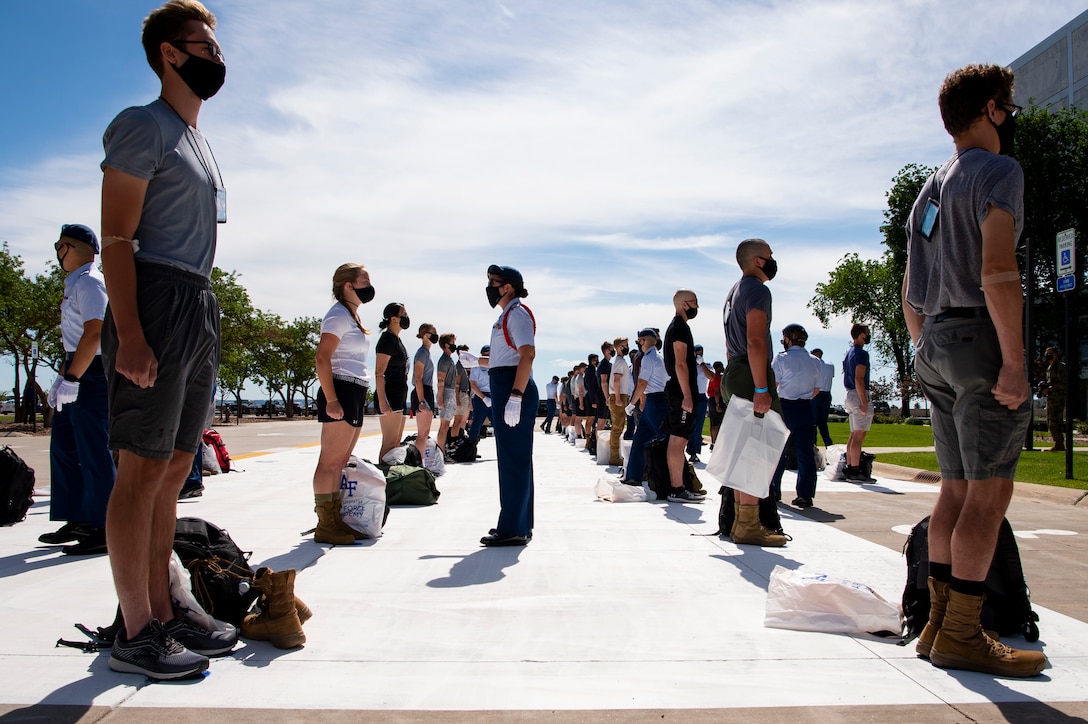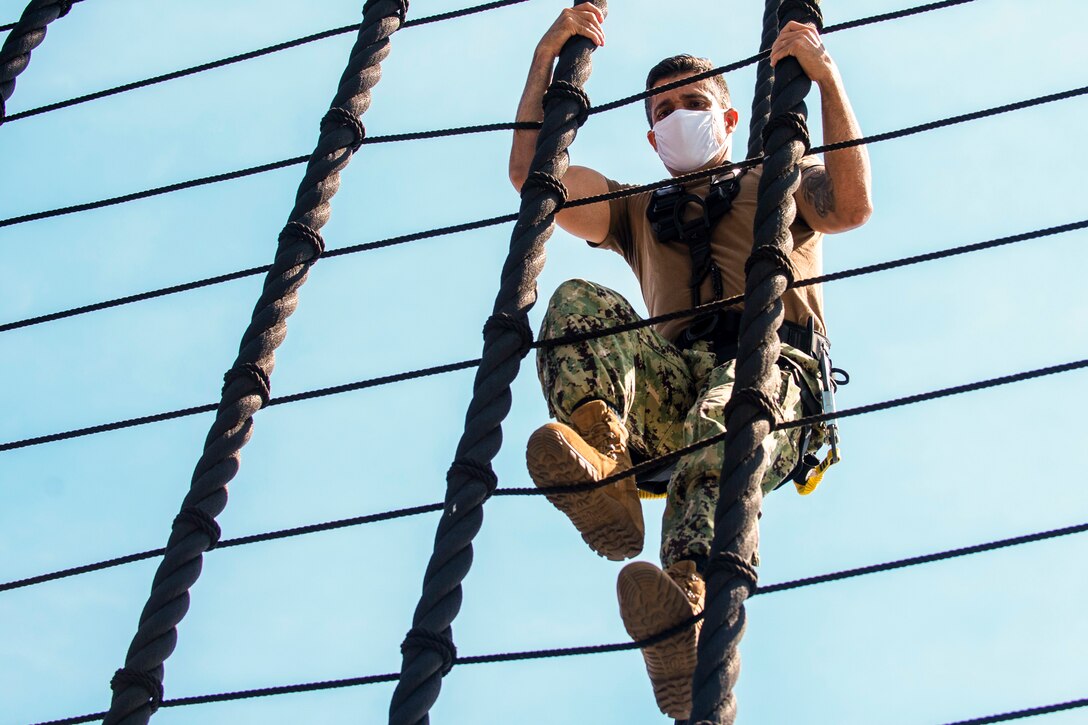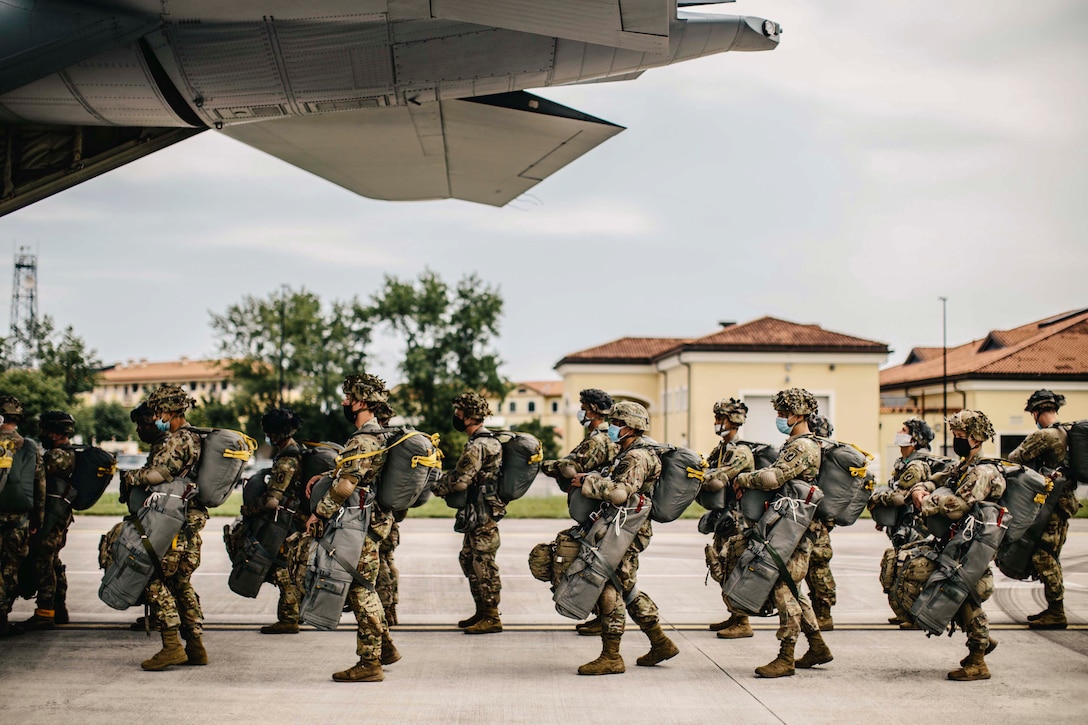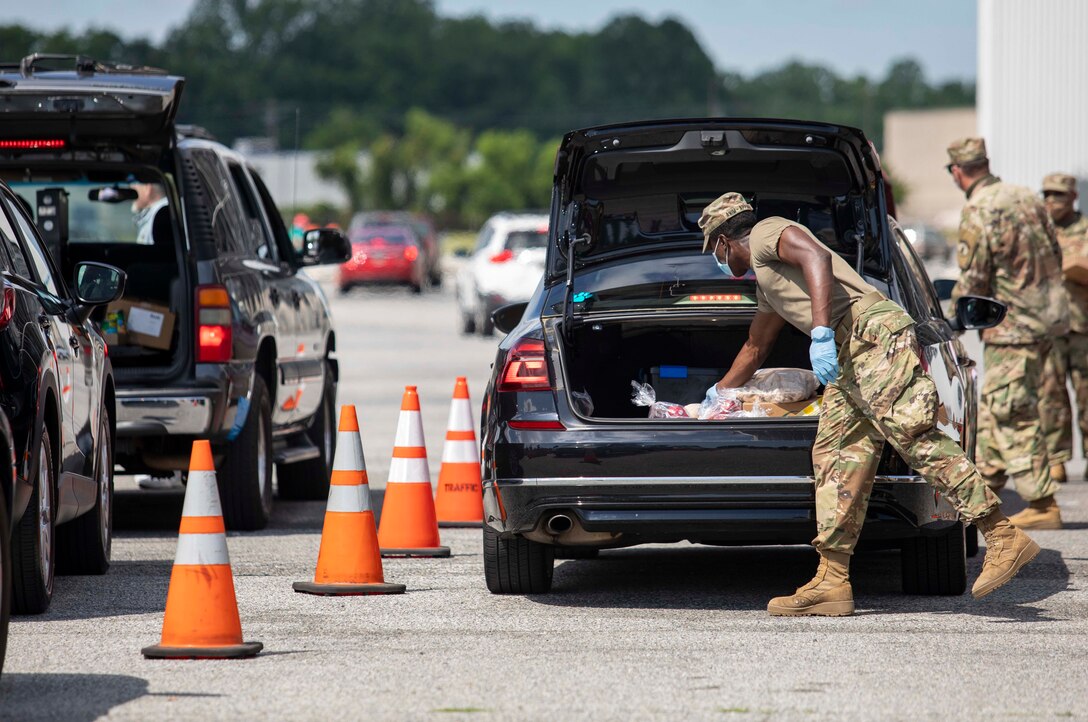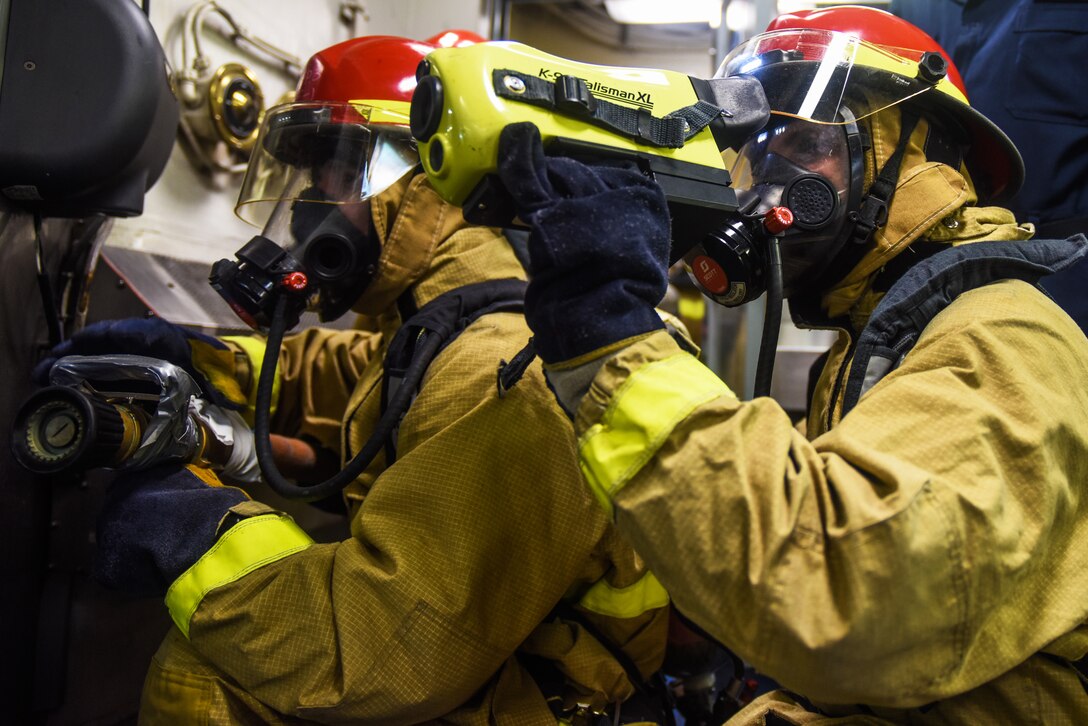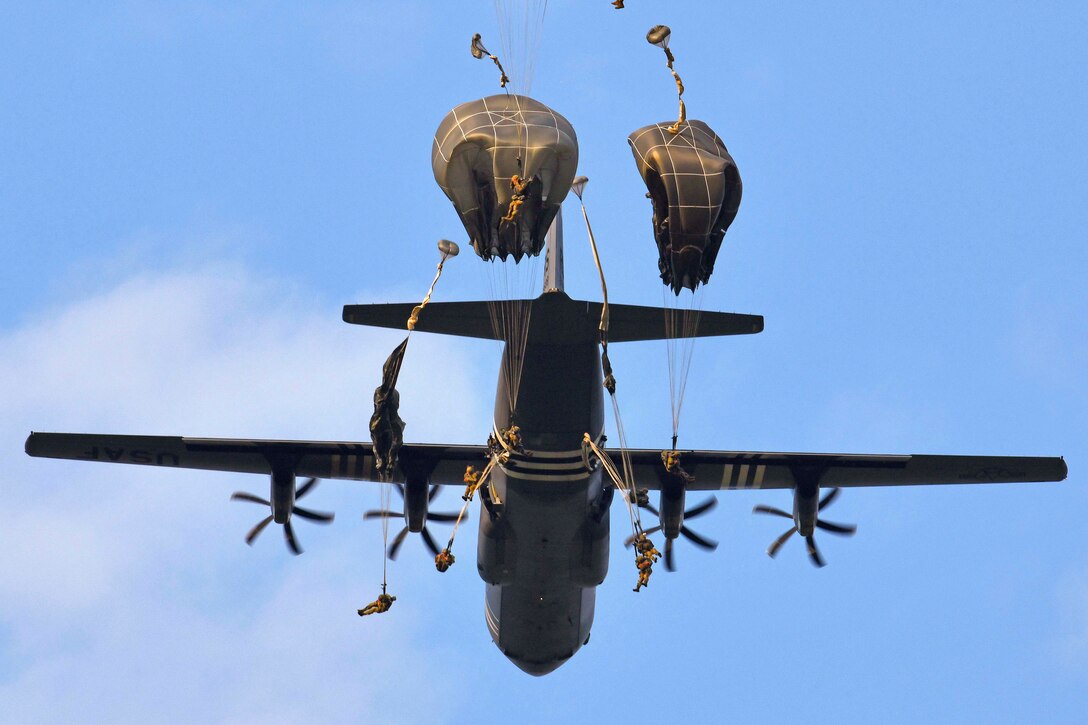Secretary Esper has approved a Department of the
Interior request for DOD support to the 2020 Salute to America. DOD will
provide aerial, musical and ceremonial support to this year’s
celebration in Washington, D.C. This year’s support will also include a
flyover of the Mount Rushmore National Memorial, as well an aerial
salute to several cities that played roles in the American Revolution.
The highlight of this year’s celebration will be our salute to the Great
Cities of the American Revolution. The flyovers will begin in Boston
and proceed to New York City, Philadelphia and Baltimore. From there
they will join other Department of Defense and heritage aircraft in the
Salute to America over our nation’s capital.
In all, roughly 1,700 service members will support the celebrations. The
exact timing of the flyovers is still being worked and will be
announced soon.
The flyovers provide an opportunity for DoD to demonstrate the
capabilities and professionalism of the United States Armed Forces.
Flying hours are a sunk cost for the Department of Defense, and these
aircraft and crews would be using these hours for proficiency and
training at other locations if they were not conducting these flyovers.
DoD is proud to help celebrate the nation’s 244th birthday. We are
grateful for our nation’s support as we defend our country, 24 hours a
day, 7 days a week, 365 days a year.
Providing up-to-date information, news and original content on American Military issues.
Friday, June 26, 2020
DOD Announces Support to Salute to America 2020
Drill Directives
Sailors receive information about a simulated casualty during a general quarters drill aboard the USS Ronald Reagan in the Philippine Sea, June 22, 2020.
Pulling it In
An Army paratrooper secures equipment after an airborne operation at Rivolto Italian Air Force Base, Udine, Italy, June 24, 2020.
Airborne Reup
Army Staff Sgt. O'Connor, a paratrooper assigned to 2nd Battalion, 503rd Infantry Regiment, 173rd Airborne Brigade reenlists while performing jumpmaster duties during an airborne operation at Aviano Air Base, Italy, June 24, 2020.
Esper Visits U.S., British Airmen at Base in England
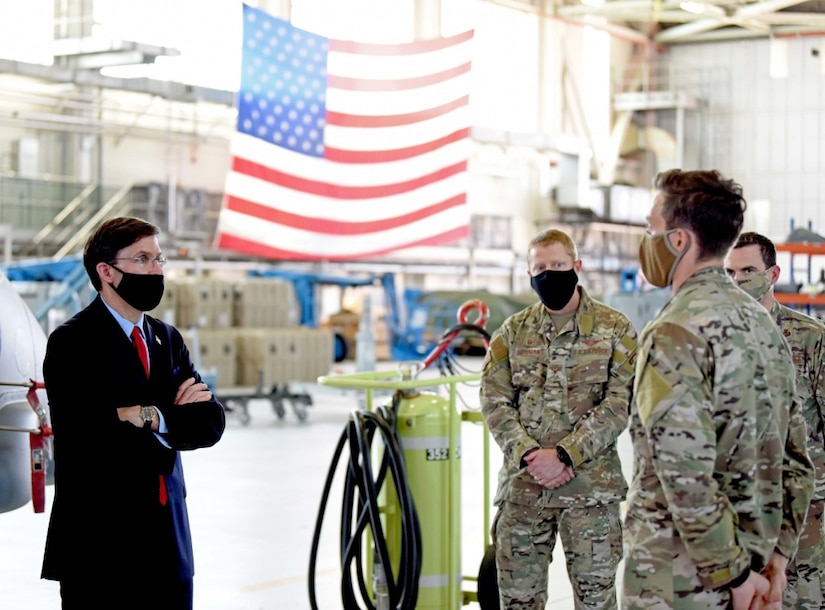
Esper met with Mildenhall airmen and families and toured the installation. He visited the air traffic control tower, static displays of a CV-22 Osprey and RC-135 Rivet Joint, and spent time talking to officers and enlisted personnel during his tour.
Esper spoke about the base's multiple mission sets, modernization of the U.S. military, and the future in promoting social equality and justice around the globe.
"My goal is to help every airman, soldier, sailor and Marine to create the strong balance needed between their professional lives and personal lives," Esper said. "People are our greatest assets, and it's my job to ensure they're not only technically sound, but physically, mentally, emotionally and spiritually cared for."
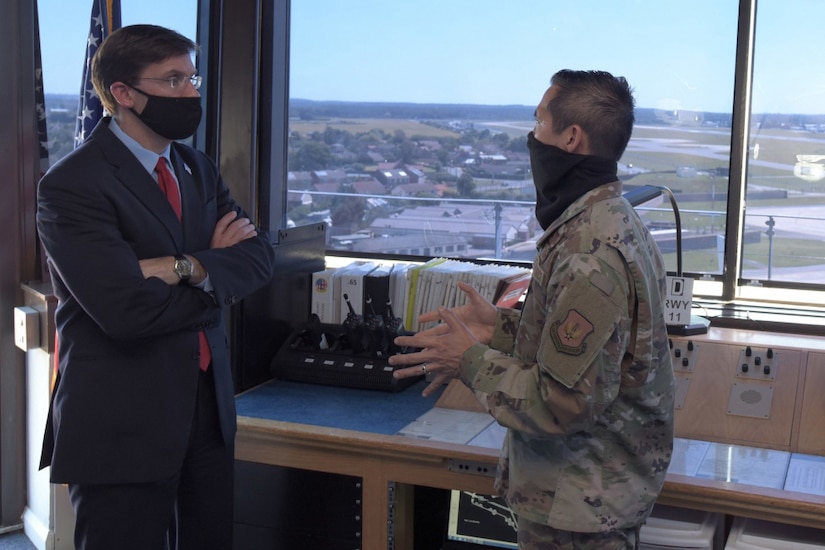
The former secretary of the Army and 27th secretary of defense spoke about the importance of RAF Mildenhall's role in the National Defense Strategy and in the national interests in both the European and African areas of responsibility.
"The various mission sets that call RAF Mildenhall home solidifies this base as one of the best assets the Air Force and the entire U.S. military has around the globe," the secretary stated. "From providing fuel, inserting operators into austere locations, gathering vital intelligence or rapid mobility of personnel and cargo, this installation is fully prepared to get the job done."
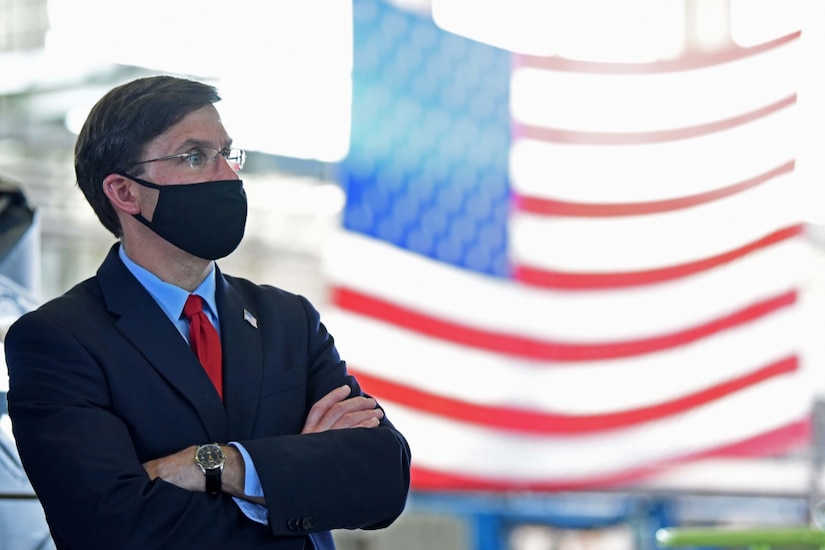
Air Force Col. S. Troy Pananon, commander of the 100th Air Refueling Wing, spoke about the importance of airmen being able to meet and discuss topics with leaders of Esper's caliber.
"I'm extremely thrilled and proud of how Team Mildenhall went out and executed Secretary Esper’s visit because these opportunities don’t always come, but when it was our time, we were ready," Pananon said. "Being able to meet, interact and present ideas to someone of Esper's stature, someone who makes very high-level decisions, is a chance I'm glad our airmen were able to take part in, and the team once again exceeded my expectations."
China Becoming Concern for U.S. Commanders in Europe
It seems counter-intuitive, but China is increasingly a concern for the commander of U.S. Naval Forces in Europe and Africa and NATO's Allied Joint Force Command.

Navy Adm. James G. Foggo told the participants of a webinar sponsored by the International Institute of Strategic Studies that China is actively working in Europe and Africa to subvert the international rules-based infrastructure that has maintained peace since the end of World War II.
China's whole-of-government approach has expanded out of the Indo-Pacific into the Arctic, Europe and Africa. In this region China is conducting unsafe intercepts of aircraft and ships, he said. It is threatening nations. China has established an overseas military base in the Horn of Africa, and is looking to control other ports.
China is "purchasing news outlets and entertainment companies to push its propaganda and erase any criticism against its government," he said. Chinese leaders are meddling in elections across the world, "restricting information about the coronavirus and donating equipment and personnel, even in Europe as a way to show that it is a world leader."
The Chinese One Belt, One Road initiative combines economic, diplomatic, military and political arms to change the international rules-based architecture. They are offering financial relief and opportunities to nations, especially in Africa, and then using that to influence the governments. "This type of influence is a security concern, and it could be used to restrict access to key seaports and airport facilities while providing access to sensitive government and military information through the technology of state-owned and state-controlled enterprises," he said.
In the past decade a lot has changed. Ten years ago, it was possible for U.S. officials to envision working with China and Russia.
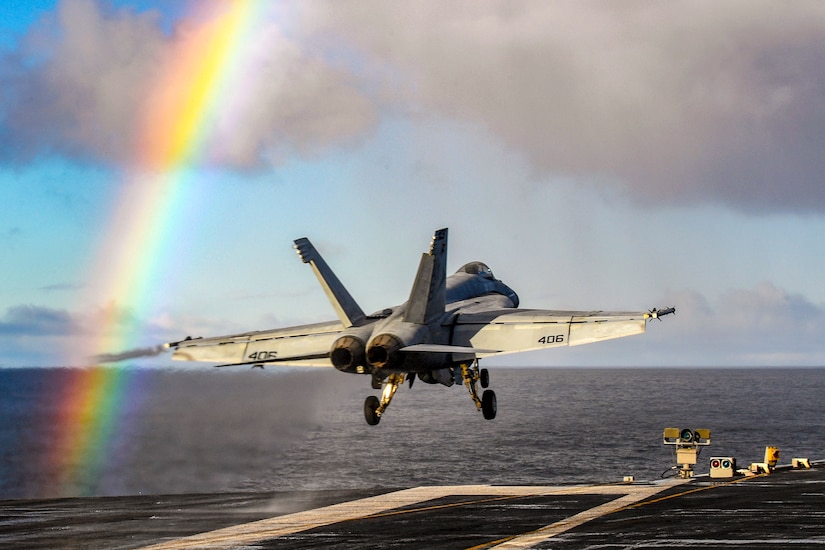
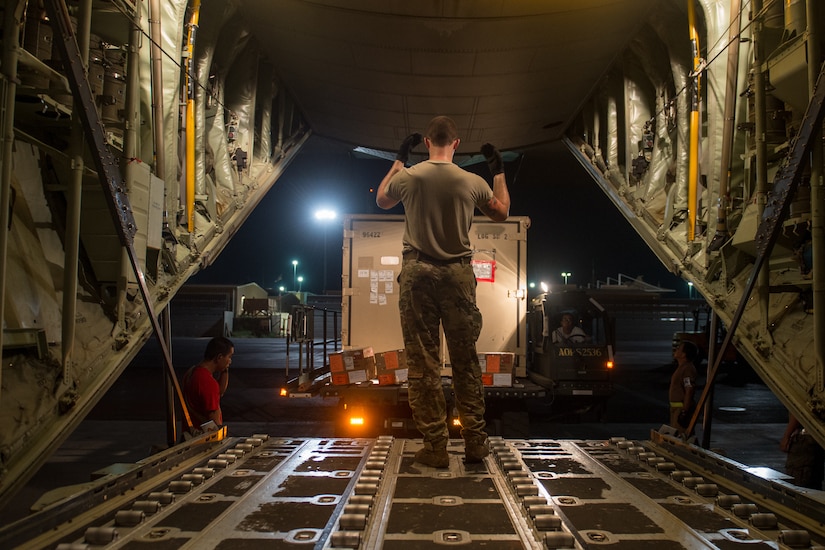
But that was before Russia illegally annexed Crimea from Ukraine. That was before China started building and fortifying islands in the South China Sea and East China Sea. That was before both nations began a huge military build-up, and before both nations conducted cyber operations against other nations. Finally, that was before Russia and China meddled in domestic politics.
"China has even labeled itself as a 'near Arctic country,'" he said, complicating an already complicated situation as new sea lanes of communication open in the North. "NATO can no longer ignore China's activities in Europe," he said. "Things like 5G — the Trojan horse. Buying port infrastructure, and the One Belt, One Road initiative."
Foggo's responsibility spans from the North Pole to South Africa, from the middle of the Atlantic to the Mediterranean, Black, Barents, Caspian and Baltic seas. There are 93 countries in this region with 23 percent of the world's population.
The admiral gave a virtual tour of the area of operations beginning with the North. The United States has long been an Arctic nation — it was Navy Rear Adm. Robert Peary who led the first expedition to reach the North Pole. "The diminishing ice coverage is causing competition to emerge in this new area," he said. "The High North is attracting global interest with abundant natural resources and opening maritime routes that have not been navigable before."
Russia, with its long Arctic coast, is aggressively pursuing its interests in the region. They are building new ice breakers and arming them with offensive weaponry. They are re-occupying old Soviet era bases. "We're seeing a new era of maritime competition in the Arctic, and strong navies are needed to protect common interests and ensure the timely flow of trade," he said.
The North Atlantic is an integral part of the name of the most successful military alliance in history. Foggo believes NATO is involved in the Fourth Battle of the Atlantic. The first battle was World War I, the second during World War II and the third being the Cold War.
Last year, unclassified sources indicated there were 10 Russian submarines underway in the North Atlantic. This is a lot even when compared to Cold War sailings, he said. Russia has also already earmarked five new attack submarines for the Northern Fleet. "We still have the competitive advantage in the undersea domain, … but they're pretty good at their tradecraft," he said.

The U.S. Second Fleet is meant to counter this development. "The North Atlantic is critical to NATO's collective security, and whoever can exert control over this region could either protect or threaten NATO's northern flank," Foggo said. "The North Atlantic is therefore synonymous with our security and our sovereignty."
The Trident Juncture Exercise in the North Atlantic and the High North was in part a demonstration to the Russians of the capabilities the alliance has and can deploy to the area. U.S. and British ships also cruised in the Barents Sea last month to reinforce the point, Foggo said.
The admiral next discussed the Black Sea and upholding international law and norms in that strategic body of water. American and NATO warships routinely conduct patrols in the Black Sea. Last year, there were around 240 days of presence in the Black Sea. "I think that's a wonderful demonstration of our commitment to our Black Sea allies and partners," he said.
The Eastern Mediterranean "is becoming one of the most kinetic places in the world," Foggo said. Russian forces are propping up the Syrian regime. They have submarines in the region capable of hitting European capitals with little warning, he said. "Routine violations of sovereign airspace and dangerously … unsafe intercepts have become standard operating procedure for Russia," the admiral said.
Russia occupied Crimea and its strategic bases. It has forces in Syria. They have moved forces into Libya, and Foggo sees this as dangerous. "This highlights the need to maintain a vigilant, highly capable naval presence throughout European waters," he said.
The world ignores Africa at its own peril, Foggo said. "Africa is a complex continent of great importance," he said. "By 2050 one in four people in the world will live in Africa — that's 2.5 billion people. The potential African workforce will exceed China's by 2030 [and] exceed India's by 2035."
There is tremendous poverty on the continent and vast amounts of natural resources. Thirty of the top 50 most fragile states in the world are in Africa.
Working with partner nations and organizations like the African Union, U.S. and NATO security experts work to build security capabilities in nations of the continent. They work to promote connectivity among the nations of the continent and intelligence sharing.
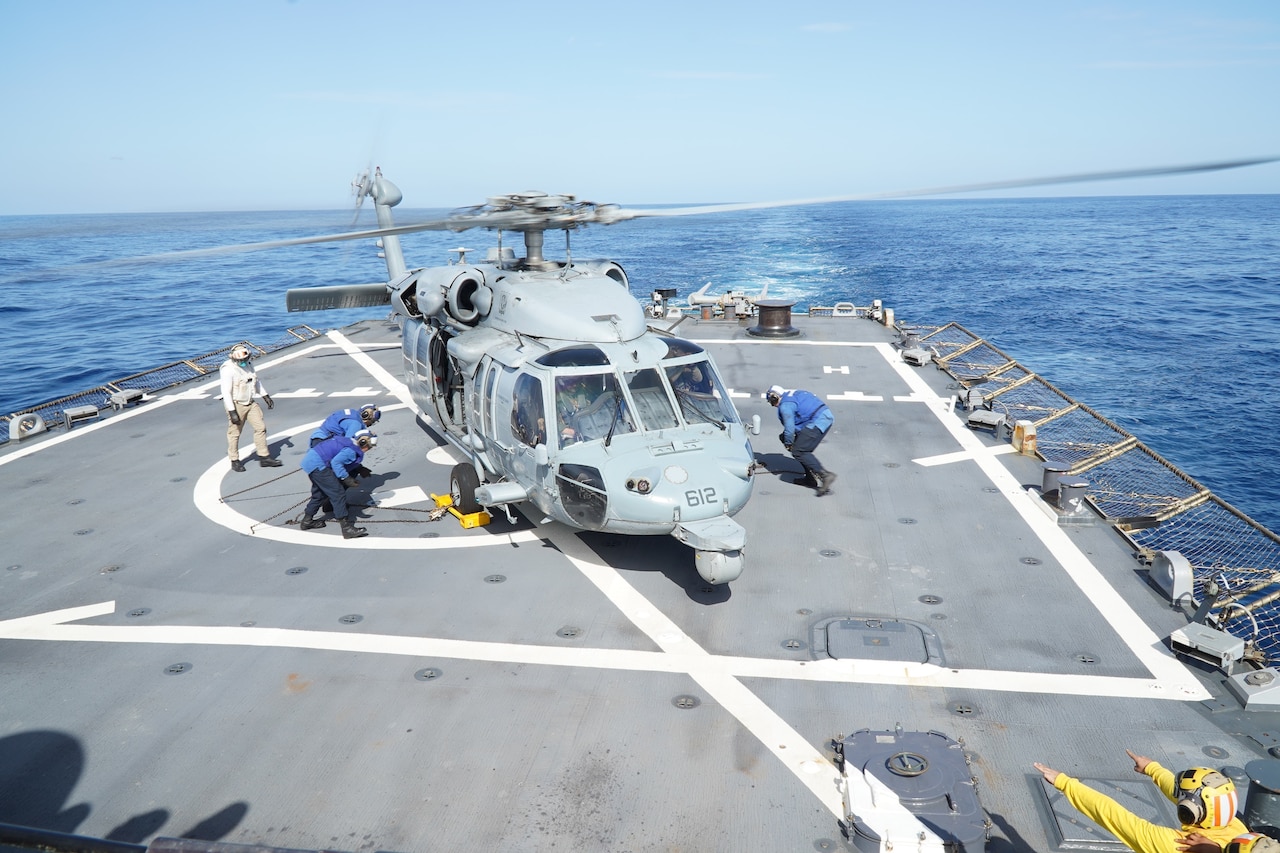
"I think we're making a difference in Africa," Foggo said. "We saw that with the development of the 2013 Yaounde (Cameroon) Code of Conduct signed by 25 Western and Central African nations as they collectively sought to address matters such as piracy, illegal fishing and illicit maritime activity. The Code of Conduct framework established objectives and improved inter-regional coastal relationships and joint capabilities. The resulting joint efforts have already reduced illegal activities in the Gulf of Guinea."
Moving forward in the entire region, the United States needs to maintain and build the relationships from the High North to the Cape of Good Hope, the admiral said. "You can't surge trust, it has to be developed over time," he said. "We also need to reevaluate our force structure, and we need to champion what we have here in the theater."
There also has to be a re-evaluation of NATO's maritime strategy. The last look came in 2011, before a resurgent Russia and a newly active China.
"Our collective strength, that ability to project power with the help of our capable NATO allies and partners is what enables us to confidently state that there truly is no competition in this era of great power competition that we cannot overcome," he said.
Cadet Arrival
Basic cadets from the Class of 2024 follow social-distancing precautions during their arrival at the U.S. Air Force Academy in Colorado Springs, Colo., June 25, 2020. These new steps are the first as they begin their journey to become commissioned officers in the U.S. Air Force.
NATO Chief Talks Nuclear Arms, Burden-sharing, NATO 2030
The secretary general spoke as part of the Brussels Forum.
Arms control treaties are the best way "to reduce the number of nuclear weapons, and that will make us all safer and reduce the risk of any use of nuclear weapons," he said. "I welcome that Russia and the United States are now sitting down and talking to each other on arms control. But having said that, I also strongly support that China should be involved. China is … a global power. China has a responsibility to be part of global arms control arrangements."
China is modernizing and enlarging its nuclear arsenal and the means of delivery. "We assess that within a decade, China will have doubled the number of nuclear warheads," Stoltenberg said. "That matters for all of us."
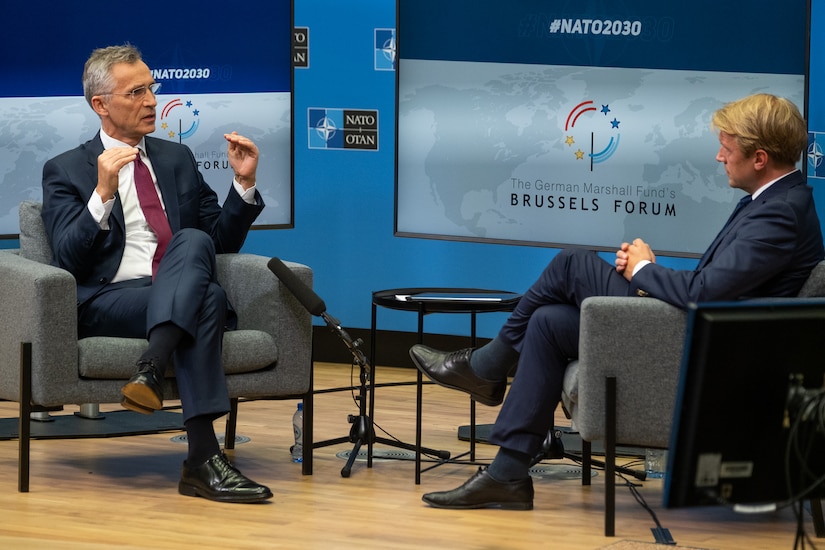
China is becoming a more important military power with long-range power projection capabilities. The effect of these moves is felt worldwide. Chinese participation in arms control negotiations would help head off an arms race, Stoltenberg said.
Stoltenberg was asked about the solidarity of the alliance, especially in light of President Donald J. Trump's insistence that allies reach the 2% of gross domestic product invested in defense.
At the same time, Trump is committed to the alliance, Stoltenberg said. "He has also now publicly, several times, recognized that European allies and Canada are investing more," the secretary general said.
Eight of the 30 nations in the alliance spend 2% of GDP on defense, but all have increased spending. Since the summit in 2016, European allies have invested $130 billion more than originally planned. "That helps and it strengthens the solidarity within the alliance," he said.
It remains to be seen what effect the coronavirus pandemic will have on the economies of all nations in the alliance, he said.
Russian presence in Libya concerns the secretary general, and NATO allies have also expressed their concern for the development. "There are differences between NATO allies on the situation in Libya, at the same time, all NATO allies agree that we are concerned about the increased Russian presence in Libya," he said. "This is part of a pattern with more Russian presence in the eastern Mediterranean. We see them in Syria. We see them elsewhere."
Russia has deployed fighter jets and other military capabilities — including Russian mercenaries — to the country. "All allies are concerned about the increased Russian presence," he said. "We also agree that we need to monitor and follow this very closely and share intelligence and information on the increased Russian presence."
Stoltenberg discussed his NATO 2030 initiative at the forum saying the reason the alliance has preserved peace is because of its ability to change.
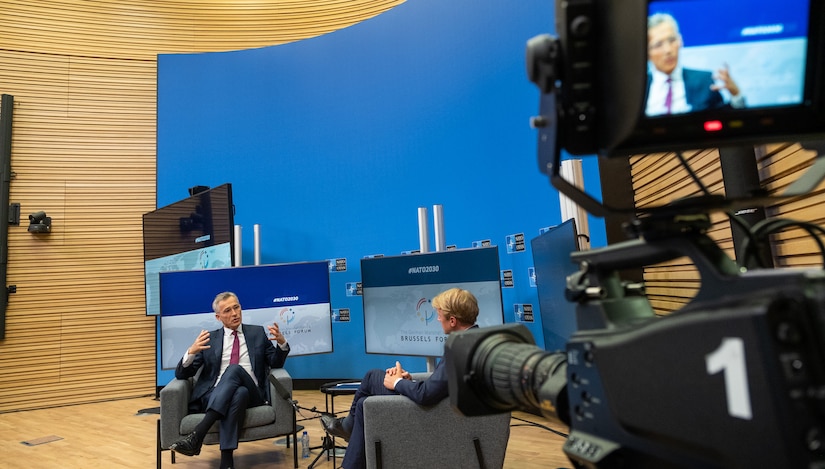
"Now we have to change again," he said. "It's about keeping NATO strong militarily, it's about strengthening NATO politically and it's about developing a more global approach to NATO."
Part of that will entail the alliance cooperating more fully with the European Union. It also requires a keen eye on China and an awareness of actions in the Mediterranean and into continental Africa.
"One of the purposes of NATO 2030, is to make sure that we adapt, that we change, as we see the world is changing," he said. "This is partly about Russia."
But it is also about China, and the effect of new technologies like artificial intelligence, big data, hypersonics and more.
"We don't regard China as an adversary," he said. "We don't see any threat against any NATO ally. But just the fact that we have such a growing power, which is actually coming closer to us in the Arctic, in Africa, in cyberspace, investing in our infrastructure here in Europe and with weapons systems that can reach all NATO allies, of course matters. That's the reason why this is part of NATO 2030."
Florida Guard Honors Miami-Dade County Fire Rescue Employees
As the Florida National Guard continues to support the state's response to the COVID-19 pandemic, strong partnerships with local agencies have become crucial to the success of the guard's ongoing mission in South Florida.
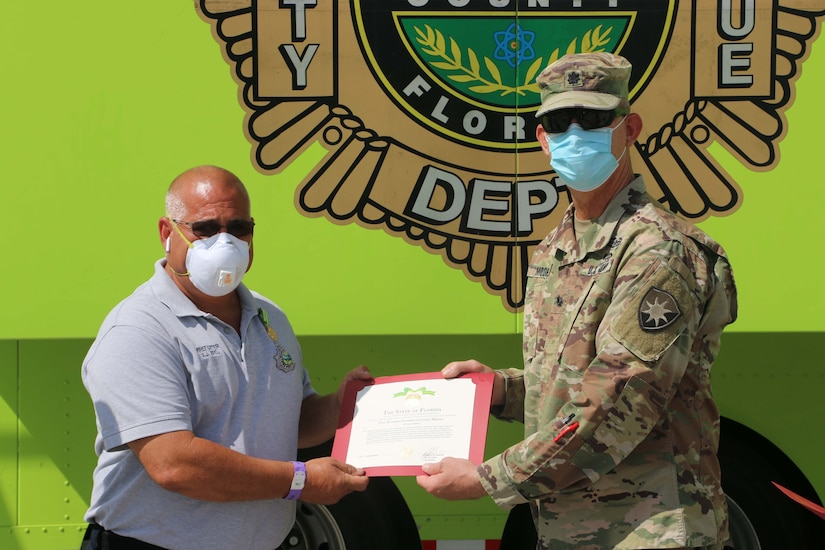
In recognition of the logistical assistance received from local partners in support of walk-up community-based testing sites in Miami-Dade County, two members of the Miami-Dade County Fire Rescue Department were recently awarded the Florida Commendation Medal.
"Having served in the Florida Guard, I appreciate all that the guard does, and understand the importance of this relationship," said Brandon Webb, battalion chief of Miami-Dade County Fire Rescue's special operations division. "The guard's presence in Miami-Dade has been instrumental in helping us serve our residents."
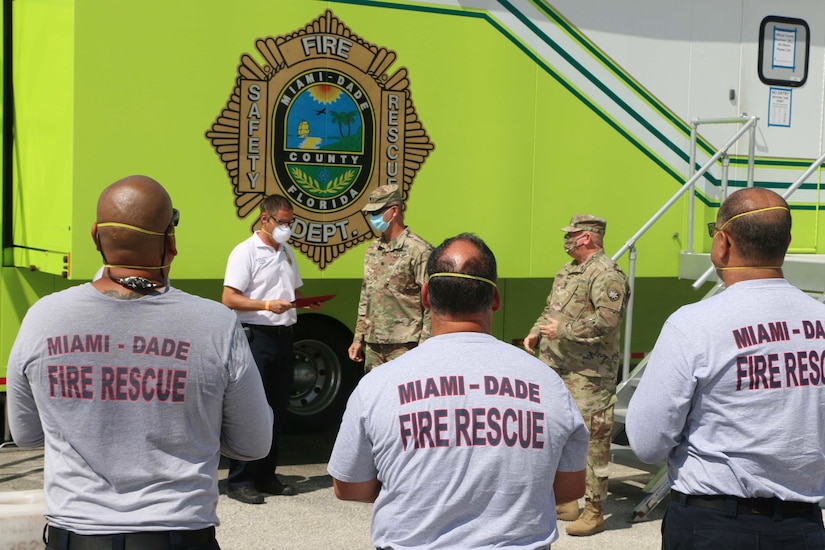
Webb served in the Florida Guard as an infantryman in D Company, 1-124th Infantry Battalion from 1991 to 1999, retiring as a noncommissioned officer. Both Webb and Arturo Abreu, the department's logistics manager, received the Florida Commendation Medal from Army Lt. Col. Jeff Moore, commander of the Florida Army National Guard’s 254th Transportation Battalion, during a ceremony held at the South Dade Government Center.
"The leadership and guidance of Chief Webb and Mr. Abreu helped us tremendously throughout our operations in support of the state's COVID-19 response in Miami-Dade," Moore said. "They helped us get what we needed, when we needed it."
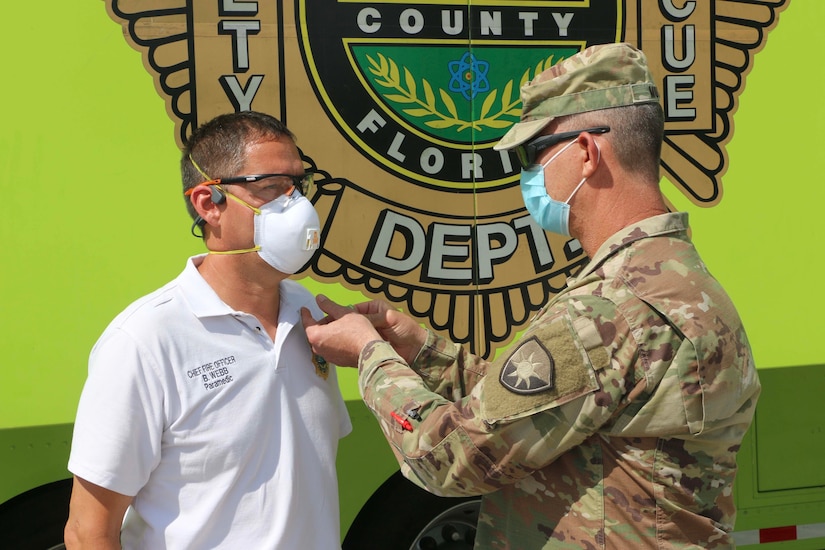
Since mid-March, the 50th Regional Support Group has served as the guard's main effort supporting the state's COVID-19 response. Working with federal, state and local authorities throughout Miami-Dade, Broward and Palm Beach counties, the 50th RSG and its subordinate units have provided direct and indirect support to more than a dozen testing locations, helping to administer more than 200,000 sample collections to date. The group’s soldiers also are supporting screening operations at three airports.
(Army Maj. Jesse Manzano is assigned to the 50th Regional Support Group.)
Africom Leaders Recognize Alconbury Airmen for COVID-19 Support
Leaders from U.S. Africa Command's intelligence directorate at Royal Air Force, Molesworth, England, presented coins of excellence to five airmen of the 423rd Medical Squadron at RAF Alconbury, England, as part of a new initiative called "Africom Aces," which recognizes mission partners who have gone above and beyond in their performance.
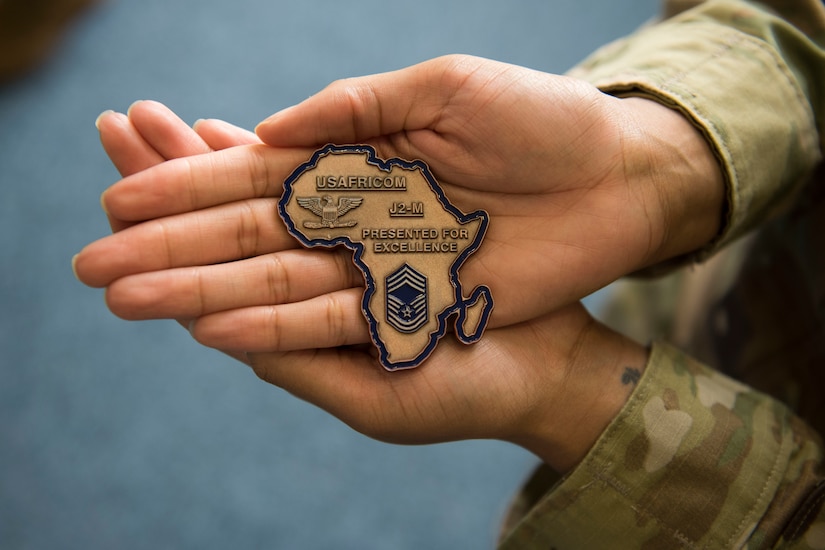
"The five public health personnel in the MDS received their coins for doing outstanding work in support of our workforce during the [COVID-19] pandemic," Air Force Chief Master Sgt. Dan Spencer, the intelligence directorate's senior enlisted advisor with Africom, said during the June 11 ceremony at RAF Alconbury.
The airmen sent daily COVID-19 reports to Africom's Joint Operations Center in Stuttgart, Germany. Those figures were relayed to Army Gen. Stephen Townsend, the Africom commander. In return, Africom sent the 423rd MDS updates about their personnel with restricted movement orders, in coordination with the command surgeon general's office in Stuttgart.
Recently, the 423rd MDS advised Africom on how to safely return to work while maintaining physical distancing guidelines.
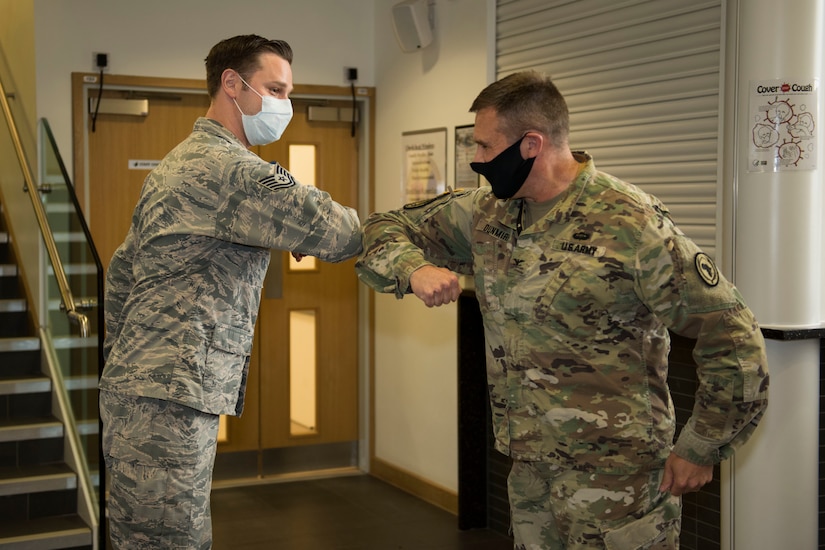
Since 2019, Spencer has been working with Army Col. Brian Dunmire, multiservice commander with Africom's intelligence directorate, to build a sense of joint cohesion among all U.S. military branches at Alconbury and Molesworth. In February, Africom hosted a Joint Immersion Day in partnership with the 423rd Air Base Group. This was an opportunity for airmen to learn more about the Army, Navy and Marine Corps.
"Africom Aces is yet another example of the things that Colonel Dunmire and I have attempted in the last year to seamlessly integrate our workforces," Spencer said. "Call it: a strategy. This builds on efforts we began with the 423rd MDS last fall for enhancing medical provider access to joint medical systems in support of readiness, volunteering joint personnel to check ID cards at the front gate of Molesworth and Alconbury, February's Joint Immersion Day in partnership with the [501st Combat Support Wing's career assistance advisor] and other continuing efforts."
Dunmire and Spencer said they launched this initiative to recognize the outstanding work of personnel at Africom's mission partners and in the off-base community. The purpose, they explained, is to recognize individuals while showcasing how important mission partners are to Africom's success, for their contributions in meeting the nation's strategic intent on the African continent, and to continue to foster deeper base-community relationships.
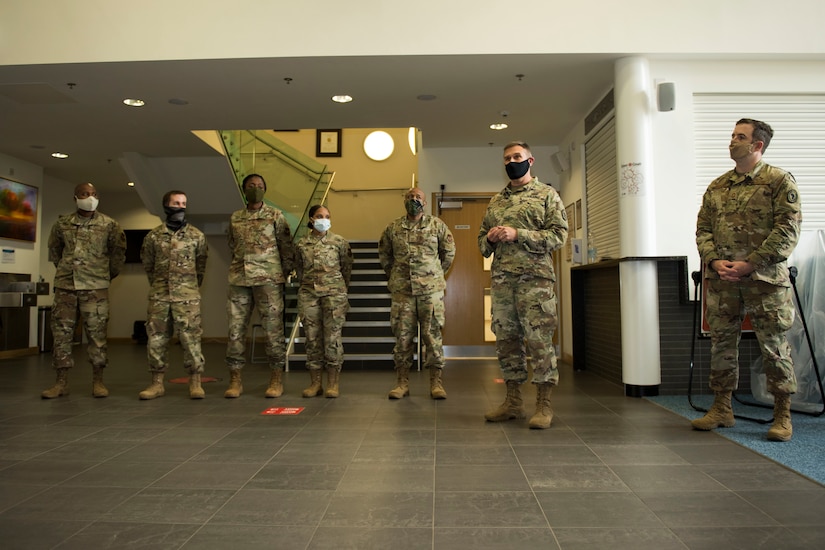
"We fully intend to crowd-source Africom Aces among our workforce," Spencer said. "This means that if any member of our workforce notices a mission partner teammate going above and beyond in performance of their job, they can nominate that person for consideration as an Africom Ace to Colonel Dunmire and myself. Then, we'll work with their leadership to recognize that person."
Employees of the 501st Combat Support Wing, 423rd Air Base Group, the Joint Analytic Center, the Battlefield Information Collection and Exploitation System, the Defense Intelligence Agency and the off-base community itself are eligible, he added.
(Air Force Airman 1st Class Jennifer Zima is assigned to the 501st Combat Support Wing.)
Standing Watch
Navy Petty Officer 2nd Class Kelsey O'Keefe stands watch aboard a Mark VI patrol boat during expeditionary training in the Persian Gulf, June 22, 2020.
Expeditionary Training
Sailors assist in the launch and recovery of a combat rubber raiding craft aboard a Mark VI patrol boat during expeditionary training in the Persian Gulf, June 22, 2020.
New York National Guard Restructures COVID-19 Response
After 100 days of operations, the six regional joint task forces established to provide maximum operational flexibility were consolidated into just two headquarters.
The response force has decreased in number from its 3,600 personnel on duty and is expected to continue to decline, as the New York National Guard focuses on supporting several core pandemic response missions, officials said.
The current force structure includes 2,459 soldiers; 353 airmen; 76 members of the New York Guard, the state's self-defense force; and 71 members of the New York Naval Militia.
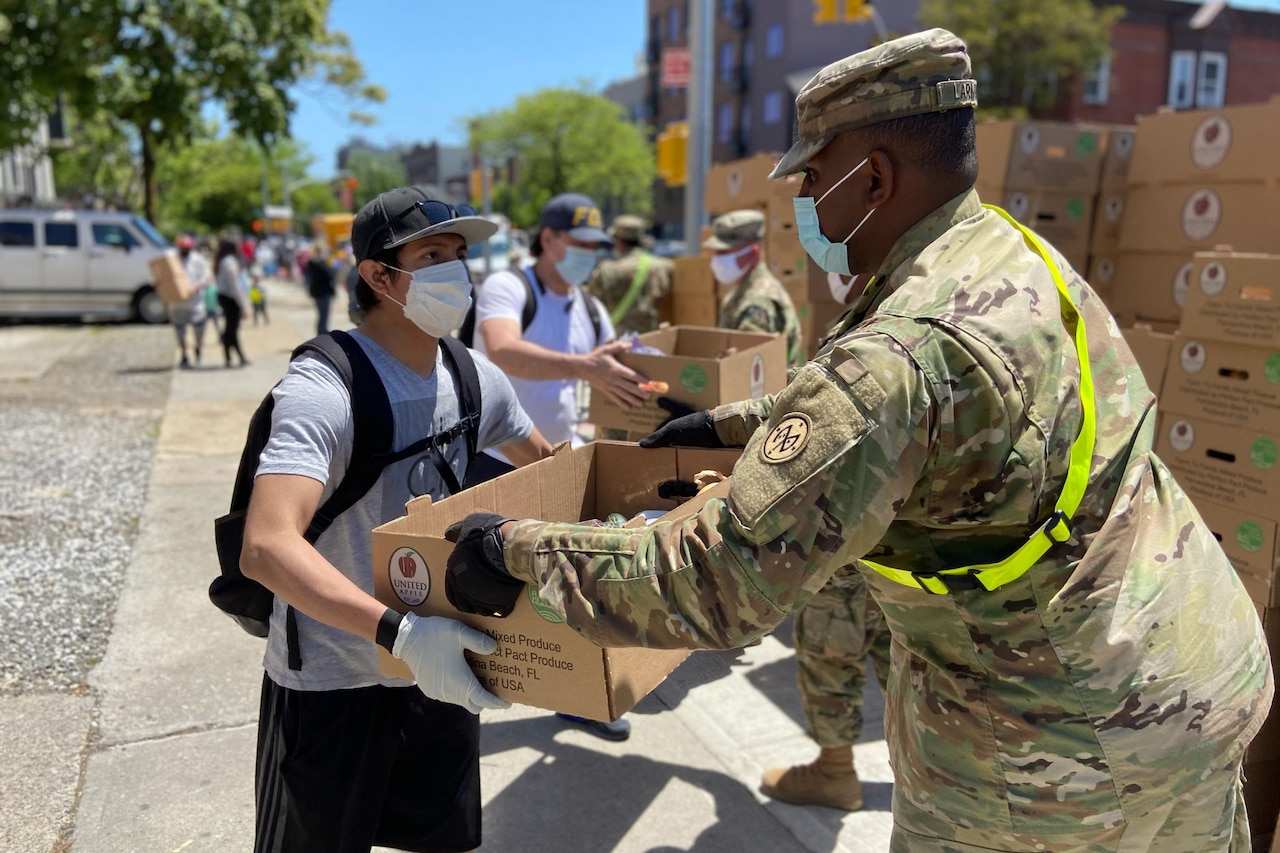
The two new headquarters are Joint Task Force North, based at the Thompson Road Armory at Hancock Field Air National Guard Base in Syracuse and Joint Task Force South, operating from the Lexington Avenue Armory in Manhattan.
Joint Task Force South will handle missions and operations in New York City, Long Island and in the New York suburbs of the lower Hudson Valley. Joint Task Force North will be responsible for operations throughout the rest of the state.
The ongoing missions tasked to the Guard include assisting state-run medical testing sites; warehouse support and logistics missions; food distribution in New York City, Westchester County, and upstate areas as required; and call center support.
A major mission to assist the Office of the Chief Medical Examiner in removing remains of those in the city who died at home was phased out June 13. More than 400 New York National Guardsmen were involved in that mission and conducted the dignified recovery of 2,882 decedents.
Guardsmen also assisted Orange County and Westchester County with similar missions and assisted the medical examiner's office in reorganizing human remains in refrigerator trailers used for the overflown morgue space.
On June 16, Army Maj. Gen. Ray Shields, the New York adjutant general, announced an initiative in which the Walter Reed Army Institute of Research will work with soldiers and airmen who conducted those decedent recovery missions. The institute has developed a tool to assess service members at regular intervals to determine their psychological health, Shields said in an email to the force.
"The entire leadership team strongly encourages participation in this study," Shields said.
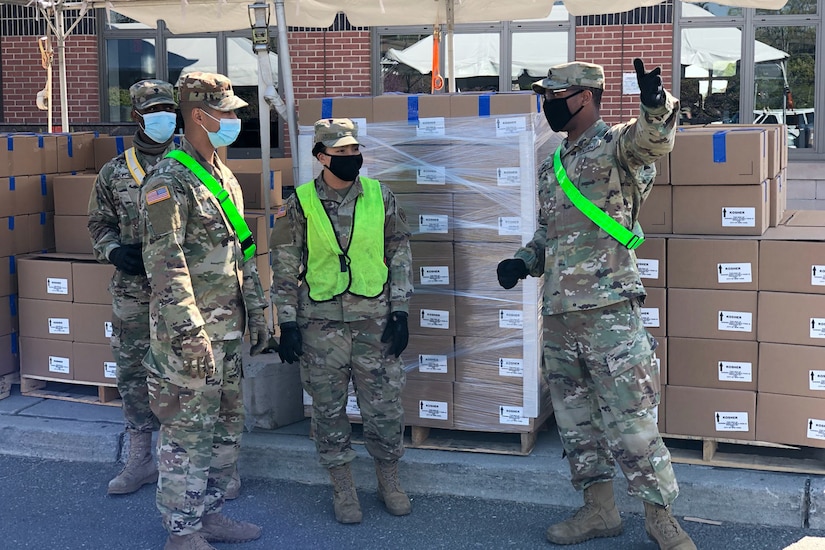
The New York National Guard will also work with the National Guard Bureau's Warrior Resilience Fitness Division to conduct studies of the personnel to assist their wellness and resilience after participating in the COVID-19 response mission. That assessment will evaluate stressors associated with deploying for the COVID-19 response, those members who did not deploy and the impacts of family and community stress in dealing with COVID-19.
Senior leaders will use the results of this study across the country to inform programs regarding resilience, Shields said. "Both of these efforts will help the total force and improve resilience programs," he added, "so I hope we get maximum participation."
New York guardsmen continue to assist state employees at 20 medical testing sites located across New York. Five of these are antibody testing sites, and 15 are drive-thru COVID-19 testing locations.
Since beginning these missions, the Guard has assisted in 13,649 antibody tests and 336,799 COVID-19 tests.
Since the beginning of the pandemic, testing has increased across New York, and about 50,000 people are being tested each day at various locations. In the past 109 days, 3.1 million New Yorkers have been tested for COVID-19, according to the governor, and 385,142 people have tested positive.
Expanded testing is critical to the safe and successful reopening of the state, Cuomo said.
The number of New Yorkers testing positive had fallen below 1%, Cuomo said on June 16. On that day, out of 59,341 tests conducted, there were only 517 positive results for COVID-19.
New York guardsmen continue conducting logistics missions, including warehousing and commodity distribution of medical supplies at five sites in the Hudson Valley-Albany area, Mohawk Valley and New York City.
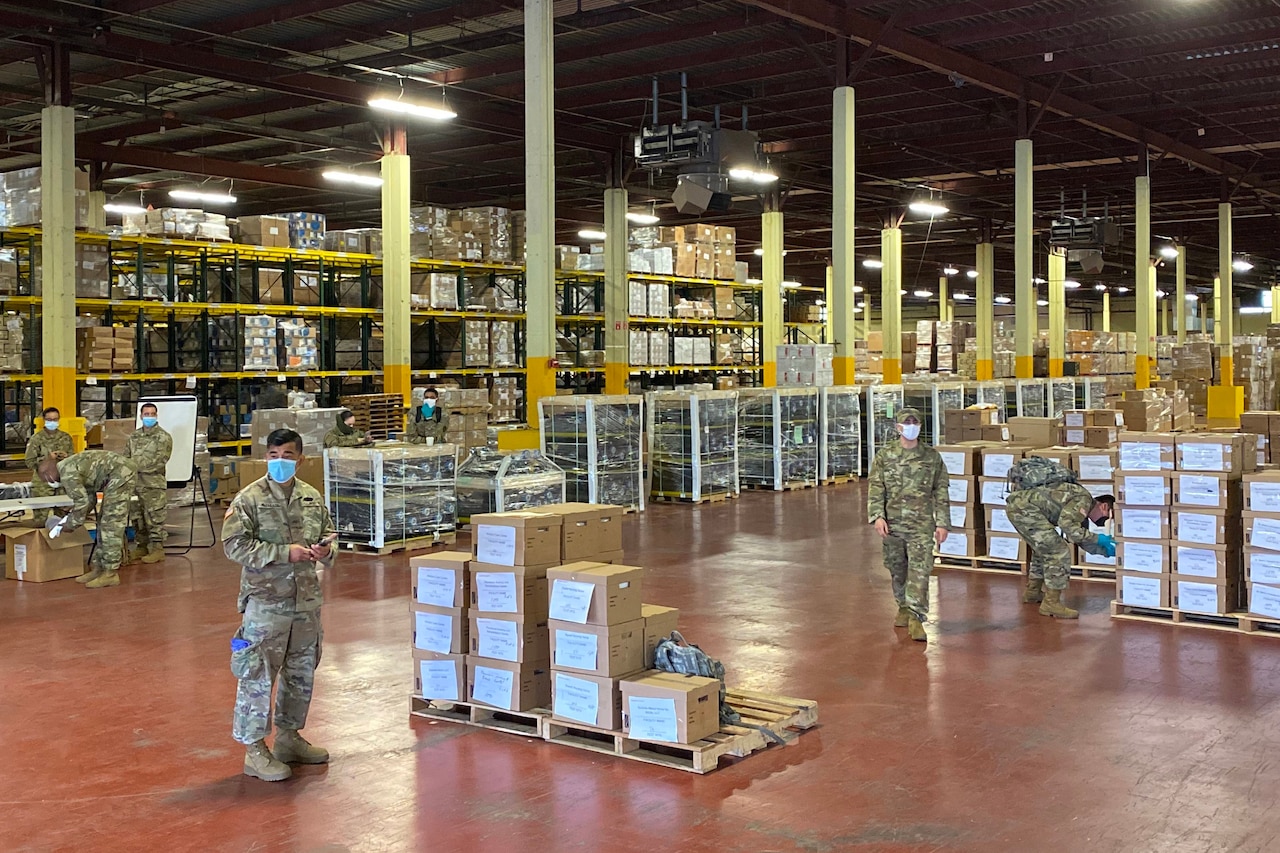
A major part of that mission has been consolidating medical supplies from a warehouse in Oriskany and a hangar at Stewart Air National Guard Base in Newburgh to the Marcy Avenue Armory in New York City.
Soldiers have moved 714 pallets of personal protective equipment and 1,029 pallets of other equipment in conjunction with the New York State Department of Transportation.
They have delivered 360,000 masks to New York City locations and will receive and warehouse 845,000 medical gowns, 2.2 million protective masks, 4,000 oxygen cylinders and another 150 pallets of supplies at four other locations. In the lower Hudson Valley, 87,596 gallons of sanitizer have been distributed since the start of the mission.
Meanwhile, soldiers are working with state officials to ensure that all goods are properly accounted for.
Finally, teams of guardsmen continue working with the New York State Department of Health's Wadsworth Laboratory in Albany to assemble COVID-19 test sets. A total of 2,038,426 test kits have been built since the start of the mission.
Sail Qualifier
Navy Senior Chief Petty Officer Jans Valdespou climbs the main mast of the USS Constitution during sail training qualification in Boston, June 23, 2020.
Soldier Line
Army paratroopers board an aircraft for an airborne operation at Aviano Air Base, Italy, June 24, 2020.
Trunk Load
Army Spc. Kwabena Anim-Appiah, a combat medic assigned to Delaware Army National Guard Medical Detachment, places food in a vehicle at a drive-thru mobile pantry in Dover, Del., June 24, 2020.
Thermal Imagers
Navy Petty Officer 3rd Class John Sunekaer, right, uses a firefighter’s thermal imager while Seaman Trevor Kingman combats a simulated fire during a drill aboard the USS Ronald Reagan in the Philippine Sea, June 22, 2020.
Airborne Ops
Army paratroopers exit an Air Force C-130 Hercules aircraft over Rivolto Italian Air Force Base, Italy, June 24, 2020.
